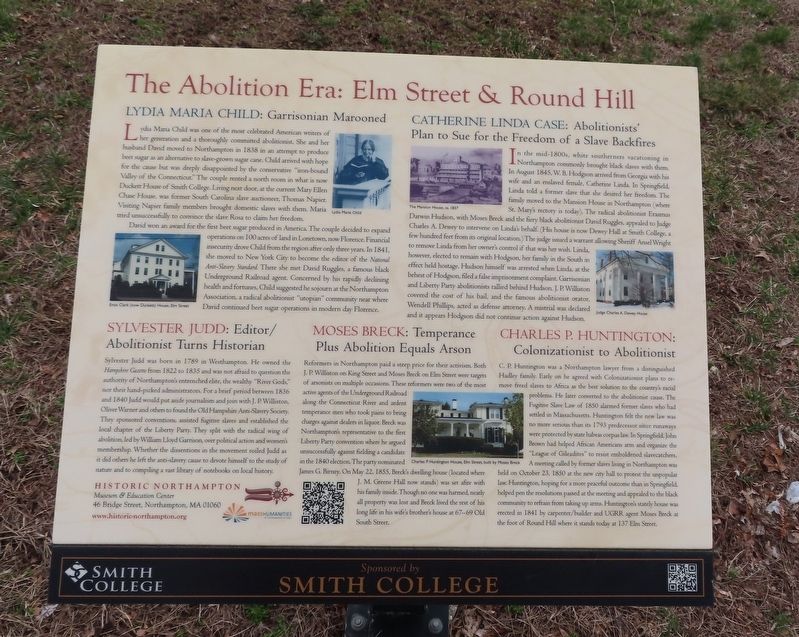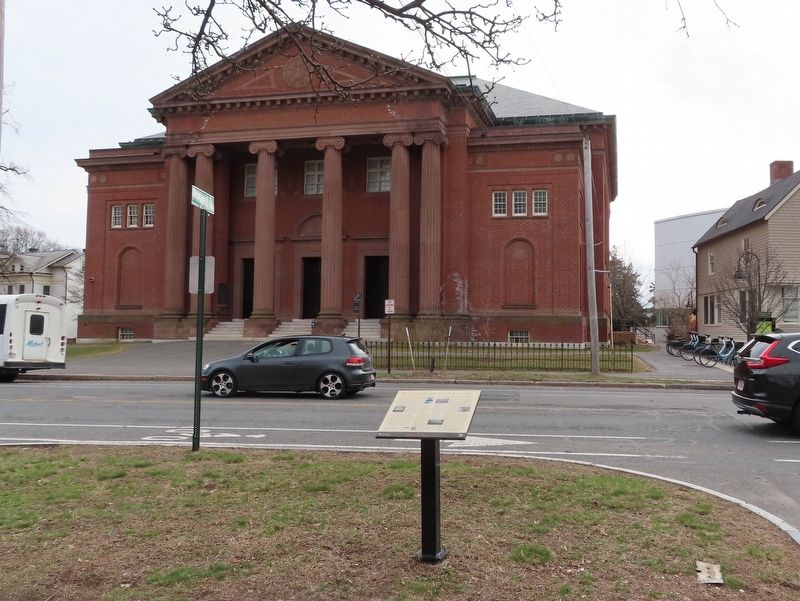Northampton in Hampshire County, Massachusetts — The American Northeast (New England)
The Abolition Era: Elm Street & Round Hill
Inscription.
Lydia Maria Child: Garrisonian Marooned
Maria was one of the most celebrated American writers of her generation and a thoroughly committed abolitionist. She and her husband David moved to Northampton in 1838 in an attempt to produce beet sugar as an alternative to slave-grown sugar cane. Child arrived with hope for the cause but was deeply disappointed by the conservative "iron-bound Valley of the Connecticut." The couple rented a north room in what is now Duckett House of Smith College. Living next door, at the current Mary Ellen Chase House, was former South Carolina slave auctioneer, Thomas Napier. Visiting Napier family members brought domestic slaves with them. Maria tried unsuccessfully to convince the slave Rosa to claim her freedom.
David won an award for the first beet sugar produced in America. The couple decided to expand operations on 100 acres of land in Lonetown, now Florence. Financial insecurity drove Child from the region after only three years. In 1841, she moved to New York City to become the editor of the National Anti-Slavery Standard. There she met David Ruggles, a famous black Underground Railroad agent. Concerned by his rapidly declining health and fortunes, Child suggested he sojourn at the Northampton Association, a radical abolitionist "utopian" community near where David continued beet sugar operations in modern day Florence.
Catherine Linda Case: Abolitionists' Plan to Sue for the Freedom of a Slave Backfires
In the mid-1800s, white southerners vacationing in Northampton commonly brought black slaves with them. In August 1845, W.B. Hodgson arrived from Georgia with his wife and an enslaved female, Catherine Linda. In Springfield, Linda told a former slave that she desired her freedom. The family moved to the Mansion House in Northampton (where St. Mary's rectory is today). The radical abolitionist Erasmus Darwin Hudson, with Moses Breck and the fiery black abolitionist David Ruggles, appealed to Judge Charles A. Dewey to intervene on Linda's behalf. (His house is now Dewey Hall at Smith College, a few hundred feet from its original location.) The judge issued a warrant allowing Sheriff Ansel Wright to remove Linda from her owner's control if that was her wish. Linda, however, elected to remain with Hodgson, her family in the South in effect held hostage. Hudson himself was arrested when Linda, at the behest of Hodgson, filed a false imprisonment complaint. Garrisonian and Liberty Party abolitionists rallied behind Hudson. J.P. Williston covered the cost of his bail, and the famous abolitionist orator, Wendell Phillips, acted as defense attorney. A mistrial was declared and it appears Hodgson did not continue action against
Hudson.
Sylvester Judd: Editor/Abolitionist Turns Historian
Sylvester Judd was born in 1789 in Westhampton. He owned the Hampshire Gazette from 1822 to 1835 and was not afraid to question the authority of Northampton's entrenched elite, the wealthy "River Gods," nor their hand-picked administrators. For a brief period between 1836 and 1840 Judd would put aside journalism and join with J. P. Williston, Oliver Warner and others to found the Old Hampshire Anti-Slavery Society. They sponsored conventions, assisted fugitive slaves and established the local chapter of the Liberty Party. They split with the radical wing of abolition, led by William Lloyd Garrison, over political action and women's membership. Whether the dissentions in the movement roiled Judd as it did others he left the anti-slavery cause to devote himself to the study of nature and to compiling a vast library of notebooks on local history.
Moses Breck: Temperance Plus Abolition Equals Arson
Reformers in Northampton paid a steep price for their activism. Both J.P. Williston on King Street and Moses Breck on Elm Street were targets of arsonists on multiple occasions. These reformers were two of the most active agents of the Underground Railroad along the Connecticut River and ardent temperance men who took pains to bring charges against dealers in liquor. Breck was Northampton's representative to the first Liberty Party convention where he argued unsuccessfully against fielding a candidate in the 1840 election. The party nominated James G. Birney. On May 22, 1855, Breck's dwelling house (located where J. M. Greene Hall now stands) was set afire with his family inside. Though no one was harmed, nearly all property was lost and Breck lived the rest of his long life in his wife's brother's house at 67-69 Old South Street.
Charles P. Huntington: Colonizationist to Abolitionist
C.P. Huntington was a Northampton lawyer from a distinguished Hadley family. Early on he agreed with Colonizationist plans to re- move freed slaves to Africa as the best solution to the country's racial problems. He later converted to the abolitionist cause. The Fugitive Slave Law of 1850 alarmed former slaves who had settled in Massachusetts. Huntington felt the new law was no more serious than its 1793 predecessor since runaways were protected by state habeas corpus law. In Springfield, John Brown had helped African Americans arm and organize the "League of Gileadites" to resist emboldened slavecatchers. A meeting called by former slaves living in Northampton was held on October 23, 1850 at the new city hall to protest the unpopular law. Huntington, hoping for a more peaceful outcome than in Springfield, helped pen the resolutions passed at the meeting and appealed to the black community to refrain from taking up arms. Huntington's stately house was erected in 1841 by carpenter/builder and UGRR agent Moses Breck at the foot of Round Hill where it stands today at 137 Elm Street.
Historic Northampton
Museum & Education Center
46 Bridge Street, Northampton, MA 01060
www.historic-northampton.org
( photo captions )
— Lydia Maria Child
— Enos Clark (now Duckett) House, Elm Street
— The Mansion House, ca. 1837
— Judge Charles A. Dewey House
— Charles P. Huntington House, Elm Street, built by Moses Breck
Erected by Smith College.
Topics. This historical marker is listed in these topic lists: Abolition & Underground RR • Women. A significant historical date for this entry is May 22, 1855.
Location. 42° 19.197′ N, 72° 38.271′ W. Marker is in Northampton, Massachusetts, in Hampshire County. Marker is at the intersection of Elm Street (Massachusetts Route 9) and Prospect Street, on the right when traveling north on Elm Street. Touch for map. Marker is in this post office area: Northampton MA 01060, United States of America. Touch for directions.
Other nearby markers. At least 8 other markers are within walking distance of this marker. The Manse (approx. 0.2 miles away); Town Clock (approx. 0.3 miles away); The Musante Mile (approx. 0.3 miles away); Draper Hotel (approx. 0.3 miles away); Town Center (approx. 0.3 miles away); Upper Main Street (approx. 0.3 miles away); West Main Street (approx. 0.3 miles away); Pulaski Park (approx. 0.3 miles away). Touch for a list and map of all markers in Northampton.
Also see . . .
1. Lydia Maria Child (Wikipedia). (Submitted on April 6, 2022, by Michael Herrick of Southbury, Connecticut.)
2. Sylvester Judd (Wikipedia). (Submitted on April 6, 2022, by Michael Herrick of Southbury, Connecticut.)
Credits. This page was last revised on April 6, 2022. It was originally submitted on April 6, 2022, by Michael Herrick of Southbury, Connecticut. This page has been viewed 220 times since then and 22 times this year. Photos: 1, 2. submitted on April 6, 2022, by Michael Herrick of Southbury, Connecticut.

